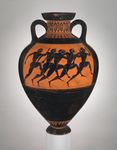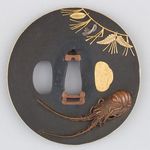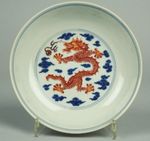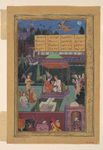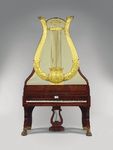The iMet Collection 2019 Challenge Dataset
←
→
Page content transcription
If your browser does not render page correctly, please read the page content below
The iMet Collection 2019 Challenge Dataset
Chenyang Zhang1 , Christine Kaeser-Chen1 , Grace Vesom5 , Jennie Choi3 , Maria Kessler3 , and Serge
Belongie1,3
1
Google Research
2
The Metropolitan Museum of Art
arXiv:1906.00901v2 [cs.CV] 4 Jun 2019
3
Cornell University and Cornell Tech
5
Arraiy, Inc.
Abstract
Existing computer vision technologies in artwork recog-
nition focus mainly on instance retrieval or coarse-grained
attribute classification. In this work, we present a novel
dataset for fine-grained artwork attribute recognition. The
images in the dataset are professional photographs of clas-
sic artworks from the Metropolitan Museum of Art, and
annotations are curated and verified by world-class mu-
seum experts. In addition, we also present the iMet Col-
lection 2019 Challenge as part of the FGVC6 workshop.
Through the competition, we aim to spur the enthusiasm of
the fine-grained visual recognition research community and
advance the state-of-the-art in digital curation of museum
collections.
Figure 1. Sample images from the iMet Collection dataset.
1. Introduction
tion. Compared to previous artwork datasets, the proposed
Fine grained visual categorization (FGVC) has emerged dataset features the following two characteristics:
as a popular research area in computer vision in recent • Fine-grained The proposed dataset contains diverse
years. With the rapid progress of deep neural networks, attributes from a specialized domain.
computer vision algorithms can now capture powerful rep-
resentations for complex semantics in domains such as fash- • Research-grade Museum experts curated and verified
ion and biodiversity. Large-scale datasets such as COCO attribute labels to ensure high quality.
[6] and ImageNet [2] have played important roles in help-
ing advance state-of-the-art algorithms for coarse-grained
2. The iMet Collection Dataset
category recognition, and the emergence of FGVC datasets The Metropolitan Museum of Art in New York (The
provide a complementary role for a wide variety of subcat- Met) has a diverse collection of artworks from across the
egories. globe spanning 5,000 years. The artworks in The Met’s col-
Previous works on artwork recognition focus mainly on lection include paintings, musical instruments, prints, arms
instance retrieval [1, 4], mid-level attributes such as color and armor, clothing, sculpture, furniture, metalwork, and
[9], and person detection [3]. Other datasets feature descrip- more.
tive attributes such as style, theme and mood [5, 8]. In 2017 The Met launched its Open Access Program
In this work, we present a novel dataset, iMet Collection making over 375, 000 artwork images and data in its collec-
2019, focusing on fine-grained artwork attribute recogni- tion available under Creative Commons CC0 license. The
1(1)
Vendor-labeled attributes were added by a professional
outsourced organization from a taxonomy provided by The
(2) Met. The annotators were able to view the museum’s online
collection pages and were advised to avoid annotating labels
(3)
already present. Specifically, the vendor was advised to an-
(4)
notate labels which can be visually inferred (e.g. “Shellfish”
in Figure 1, bottom-right sword guard). These annotations
can be potentially more intuitive and visually plausible.
We have included 1103 different attributes from both
Figure 2. Left: distribution of images per attribute label. Right: culture-related attributes from SME derived attributes and
representative images for 4 sampled attributes. vendor-sourced attributes in the final dataset.
2.3. Data Splits and Sizes
Open Access data includes object type, artist, title, period,
creation date, medium, culture, dimensions, and geographic We divide the dataset into three splits: training, vali-
information. The Met recently added subject keyword tags dation, and test subsets. While the training and validation
to their Open Access Program to improve discoverability splits were released during the competition, we retained the
and increase access to the collection. Together the data and test split for final ranking and will release it afterwards.
the subject keyword tags can also be used for content sug- Since each data sample is annotated with 1 or more at-
gestion and a better means to navigate the collection. tributes, we first randomly pick a “pivot” attribute label for
To scale the coverage of the subject keyword tags to all each sample. Then we split the dataset using the “pivot”
artwork images, we might need to leverage more automated attribute labels in the following manner:
annotation algorithms. To that end, we release the iMet Col-
lection dataset consisting of images with groundtruth key- 1. We discard samples whose pivot attributes have fewer
word labels, which could facilitate the research in computer than three samples.
vision algorithms for keyword annotation as well as other 2. If an pivot attribute has fewer than 10 samples, we as-
applications. sign one to each of validation and test set, and the rest
to training set.
2.1. Images
3. Otherwise, we assign 70%, 5%, and 25% of them to
All images from our dataset are supplied by The Met and training, validation, and test, respectively.
are all publicly available under CC0 license.1 While there
Finally, we reattach the non-pivot labels back to each as-
may be more than one image available for each object (art-
signed sample and discard labels which do not exist in
work instance), we only retain the ones for “main-display.”2
all three splits. In the end, our dataset contains 1103
Each image is resized such that the shorter dimension is 300
attribute labels from 155, 531 samples, among which we
pixels and is encoded in PNG format. Sample images are
have 109, 274 samples for training, 7443 for validation and
shown in Figure 1.
38, 814 for testing.
2.2. Annotations 2.4. Data Challenges
The Met’s subject keyword tags cover religious subjects, The iMet Collection 2019 Dataset has a long-tailed dis-
historical events, plants and animals. The tag set provides a tribution (Figure 2) over the attribute label set. The three
new perspective into the collection, allowing users to search most popular attributes are “Men”, “Women”, and “French”
common topics across time. (which contain 19, 974, 14, 283, and 13, 549 training sam-
The annotations of the dataset come from two sources: ples, respectively), and the least popular tag is “Afgan”,
(1) Subject Matter Experts (SME) and (2) vendor annota- having only one training sample. Another challenge is the
tors. unbalanced numbers of attributes per sample. As shown in
SME derived attributes are provided at curation time Figure 3, the number of attributes per sample ranges be-
by the SME, and may contain single or multiple labels. tween 1 and 11, while most of the samples have 2 to 4 at-
These labels are drawn from several predefined domains tributes.
such as Culture, Medium, Origin, etc. For this competition,
we only include the Culture domain for simplicity. 2.5. Metric
1 The Met Online Collection: https://www.metmuseum.org/art/collection
We evaluate the performances of our dataset following
2 Main-display refers to images capturing the most comprehensive view, the multi-label classification manner and employ the Fβ [7]
often frontal, of the object. score:40000
Number of data samples 4. Conclusions
35000
30000 Artwork attribute recognition is a novel area of research
25000 in fine-grained visual classification (FGVC) domain. In this
20000 work, we propose a novel multi-attribute image dataset to
15000 enrich the assets of this research area. The iMet Collection
10000 2019 dataset is the first high-quality artwork image dataset
5000 with research-grade attribute labels curated or verified by
0 world-class museum experts.
0 2 4 6 8 10 12 As the attribute annotation work is an ongoing effort in
Figure 3. Histogram of per-sample attribute numbers over the the Met Open Access program, we plan to extend the iMet
training set. Most samples have 2 to 4 attributes while one of the Collection challenge dataset with richer attributes covering
training sample has 11 attributes. more semantic groups, such as medium and size. In addi-
tion, we also plan to support more computer vision applica-
(1 + β 2 )T P tions such as instance detection and segmentation, caption
Fβ = (1)
(1 + β 2 )T P + β 2 F N + F P generation, and cross-modality retrieval in the future com-
where TP, FN, and FP stand for numbers of true positives, petitions.
false negatives and false positives, respectively. In the chal-
lenge, we set β = 2 to trade for more true positives with References
more tolerance to false positives. [1] Elliot J Crowley and Andrew Zisserman. In search of art.
In European Conference on Computer Vision, pages 54–70.
3. The iMet Collection Challenge 2019 Springer, 2014.
[2] Jia Deng, Wei Dong, Richard Socher, Li-Jia Li, Kai Li, and Li
Fei-Fei. Imagenet: A large-scale hierarchical image database.
0.7
In 2009 IEEE conference on computer vision and pattern
0.6 recognition, pages 248–255. Ieee, 2009.
[3] Shiry Ginosar, Daniel Haas, Timothy Brown, and Jitendra
0.5 Malik. Detecting people in cubist art. In European Conference
F-2 Score
0.4 on Computer Vision, pages 101–116. Springer, 2014.
[4] David Gorisse, Matthieu Cord, Michel Jordan, Sylvie Philipp-
0.3 Foliguet, and Frédéric Precioso. 3d content-based retrieval
in artwork databases. In 2007 3DTV Conference, pages 1–4.
0.2 IEEE, 2007.
0.1 [5] Ivan Krasin, Tom Duerig, Neil Alldrin, Vittorio Ferrari, Sami
Abu-El-Haija, Alina Kuznetsova, Hassan Rom, Jasper Ui-
0.0 jlings, Stefan Popov, Andreas Veit, et al. Openimages:
/19 0/1
9
4/1
9
8/1
9
2/1
9
4/1
9
03 /27 04/
1
04/
2
05/
0
05/
2
06/
0 A public dataset for large-scale multi-label and multi-class
image classification. Dataset available from https://github.
Date com/openimages, 2:3, 2017.
Figure 4. Challenge leader-board scores up to date. Each colored [6] Tsung-Yi Lin, Michael Maire, Serge Belongie, James Hays,
thin line represents a team with their submissions evaluated on Pietro Perona, Deva Ramanan, Piotr Dollár, and C Lawrence
validation set. The cyan thick curve indicates the leading score Zitnick. Microsoft coco: Common objects in context. In
over time among all teams. We only plot 32 teams who have the European conference on computer vision, pages 740–755.
longest date spans. Springer, 2014.
[7] David Martin Powers. Evaluation: from precision, recall and
The iMet Collection Challenge 2019 is conducted
f-measure to roc, informedness, markedness and correlation.
through Kaggle as part of FGVC6 workshop at CVPR19. 2011.
At the time of paper submission, over 500 competitors from [8] Michael J Wilber, Chen Fang, Hailin Jin, Aaron Hertzmann,
435 teams have submitted their results. We plot the public John Collomosse, and Serge Belongie. Bam! the behance
leaderboard progress over time in Figure 4. The competi- artistic media dataset for recognition beyond photography. In
tion is the first kernel-only Computer Vision challenge ever Proceedings of the IEEE International Conference on Com-
hosted on Kaggle, where the participants can only run their puter Vision, pages 1202–1211, 2017.
model within limited resources and are required to open- [9] Marchenko Yelizaveta, Chua Tat-Seng, and Aristarkhova
source their model (kernel) at the end of competition. We Irina. Analysis and retrieval of paintings using artistic color
hope that this effort can further benefit the research com- concepts. In 2005 IEEE International Conference on Multi-
munity by increasing algorithm transparency and resource media and Expo, pages 1246–1249. IEEE, 2005.
fairness.You can also read



